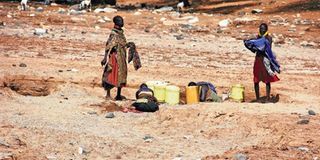Poverty ravages Turkana as new goals unveiled

Women draw water from a hole dug on a dry riverbed at Lokiriama in Turkana County for domestic use. PHOTO | JARED NYATAYA |
What you need to know:
- Kenya required to focus on innovation, reduce corruption and redistribute its wealth.
- Fifteen years since the UN passed eight millennium goals, hunger and graft still stalk the land.
Mrs Mary Lochipo’s childhood was spent on the plains of Turkana, often herding goats under the searing sun.
At the age of 30 years, she is now a mother of seven — all of them delivered at home.
Her husband, Musa Iwose, earns a living doing menial jobs in Lodwar town, some 10 kilometers away. On a good day, he earns Sh100. On other days, he spends time perched on his ekicholong — a traditional stool — as his wife weaves a basket or brooms to be sold.
Ms Ewoton Ng’ilimo, 52, too, has never left Turkana County. She is widowed with three children, two of them are married but are jobless.
THORNY BUSHES
The two families are from Nataparakakono village, a long stretch of communal land near Lodwar town patched with thorny bushes. The community faces a constant shortage of food, water and shelter.
A new school was built a few years ago from the Constituency Development Fund and supported by the county government, but the Nataparakakono children are often skipping classes for one reason or another — from trekking for kilometres in search of water and taking care of livestock to lack of fees.
“We don’t have water and the land here does not support any crops,” Ms Lochipo told the Sunday Nation.
Turkana is one of the largest counties in Kenya but it is also one of the poorest. According to the Commission on Revenue Allocation, just about 121,000 children have enrolled in primary school out of a population of 855,000. This is a small ratio given that about half of the population is aged below 14 years. The eldest of Ms Lochipo’s children is 14 and attends the local primary school where her mother hopes she will one day become a doctor and lift them from the wretched life.
It is the sort of situation that probably inspired the United Nations to develop new goals to tackle poverty.
Fifteen years ago, the UN agreed to pass eight Millennium Development Goals (MDGs), which end this year.
They included eradicating extreme poverty and hunger, achieving universal primary education, promoting gender equality and empowering women, reducing child mortality, improving maternal health, combating HIV/Aids, malaria and other diseases, ensuring environmental sustainability and developing a global partnership for development.
Critics charged that those targets were too general and ignored each country’s unique needs. Next month in New York, the UN is expected to formally approve the new targets, known as the Sustainable Development Goals (SDGs).
The new goals identify poverty as the greatest challenge and still focus on the five Ps — people, planet, prosperity, peace, and partnership — as a way of getting people out of poverty without violence or depleting the environment.
“They are people-centred and planet-sensitive. They are universal – applying to all countries while recognising different realities and capabilities,” observed UN Secretary-General Ban Ki-moon.
DEVELOPMENT GOALS
“Fundamentally, they recognise that we cannot reach our development goals without addressing human rights and complex humanitarian issues at the same time.”
Kenya will have to focus on innovation, reduce corruption and redistribute its wealth if it is to achieve the new set of global development goals.
Foreign Affairs Cabinet Secretary Amina Mohamed said the SDGs provide a clearer direction.
“The new agenda defines the requisite means of achieving it through both the financial and non-financial means of implementation. It defines the link with the means developed by the third conference on financing for development and recognises its complementary role,” she said in a statement.
The targets seek to have authorities producing accurate data about development and will be implemented and monitored through those national development indicators which will, in turn, be compared with global measures.
The new deal talks of factors which give rise to violence, insecurity and injustice, such as inequality, corruption, poor governance and illicit financial and arms flows; issues that could resonate with Kenya’s recent past.
“Build resilient infrastructure, promote inclusive and sustainable industrialisation and foster innovation,” says Goal 9 that talks about the need for reliable systems to support trans-boundary relations and generally reach everyone.
At Goal 16, the document talks of having peaceful and inclusive societies, a better justice system and accountable institutions.






